|
The postwar economic history of Pelikan is one of expansion followed by contraction.
The firm prospered through the 1950s and into the 1960s. However, the early postwar
era brought the ballpoint pen which began to catch up with Pelikan as it did with
virtually every other pen manufacturer. Nevertheless, between 1950 and 1963 Pelikan
had a remarkable run, producing the 400 in nearly as wide a range of colors and
styles as it had the 100s and, one suspects, in larger numbers. Like its early
counterparts, the 400, can be surprisingly hard to catalogue. Most commonly the
pens were offered in the traditional green and black, this time with stripes to
provide a more visible ink supply. A somewhat new model, in striped tortoise shell
with brown cap and filling mechanism became a most favored variant. In addition
there were gray and mother-of-pearl models, the latter looking like the pre-war
tortoise 101 model in the shape of the 400s, but with the new brown rather than
the red trim. The seagreen, not commonly found today, was green striped, but with
a dark green (rather than black) section, cap and filler. According to Dittmer
and Lehmann, there were also many prototypes made in extremely small numbers,
some of the most interesting with white and yellow bodies. There was also an accountant’s
pen, a traditional tortoise model, but with a red captop to signify red ink. In
addition there were the models 500, with a gold filled cap; the 520, all gold-filled;
the 600, with 14 K cap; and the 700, all 14 K. Sadly there was no white gold model.
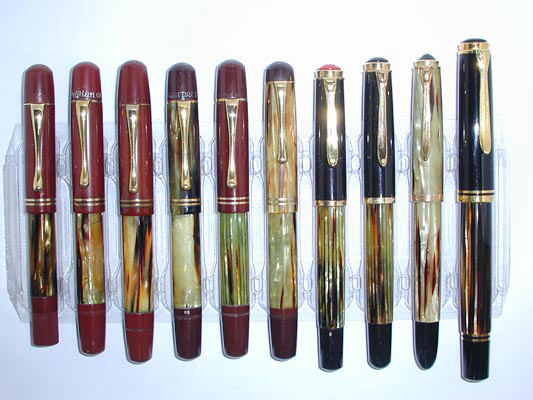
From the collection of Rick Propas/photography
by Rick Propas. Tray of Pelikan pens in tortoise. Circa 1934-1987.
In 1955 change again came to Pelikan. This restyle, however, was much less
comprehensive than that of 1938 or 1950. The pen remained essentially the same,
only the new 400N was given a slightly larger cap and a more rounded turning knob.
According to most accounts this model was sold only briefly but in a full range
of colors and types. Why the pen was produced for such a short time is anyone’s
guess. In 1956 the last of the postwar Pelikan models was introduced and would
stay in production for seven years, the 400NN. The 400NN, which kept the same
barrel as the 400, was made in all the colors of the 400.
At this point, I should note the narrow focus of this history. For the most
part I have not taken notice of the market segment that would carry most German
penmakers, the school pens. That, however, is a topic for another time. Nor, as
this story progresses, will I discuss the proliferating models—the Signums,
the Celebrys--that marked the period from 1970s to the present. They are just
too many, and in my view, they are but offshoots of the main Pelikan branch. Interested
readers are best referred to the most definitive history of Pelikan, apart from
the company’s own emerging web history, that of Dittmer and Lehmann, cited
at the end of this series.
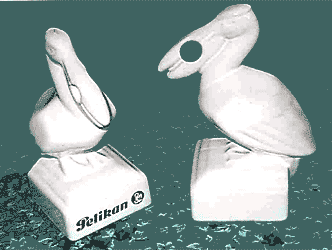
from the collection of Gerhard Brandl/photography
by Gerhard Brandl. These are contemporary.
By the 1970s, Pelikan clearly was in trouble. The pens of the 1960s, the M30-M100
series, had seen success to rival Montblanc, but the pen market was declining.
This can be seen in the proliferation of the new models and the advent of outside
management. Despite the success of the 400 line and its offshoots, the ballpoint
pen was the writing instrument of choice in a fast changing world. Like many others,
such as Parker, Pelikan was slow to introduce its “Roller,” the ballpoint
accompaniment to the 400 series, which came only in 1955.
In this new environment, penmakers everywhere scrambled to make fountain pens
more relevant to the postwar world. Parker, of course, was one of the most successful
with its “51” model introduced during the war in 1941. It was followed
by the 61 (this time without the quotation marks). The “51” pioneered
the hooded nib and set the idiom for fountain pens in the early postwar world.
It was also copied widely by firms like Aurora, Onoto and Platinum. Pelikan’s
answer was the P1. The pen was an awkward looking copy of the 61, but did incorporate
traditional Pelikan quality and some innovations from none other than Theodor
Kovacs who had developed the piston 40 years earlier. Still the pen offended many
Pelikan users and like the Parker 61 it used poorly made, lightweight plastic.
The model lasted only five years and was a failure according to Lambrou. Alongside
the P1 Pelikan launched a broad range of models, the most successful of which
was a new school pen, the Pelikano, first sold in 1959 and made to this day.
Despite the fact that the company continued under the ownership of the Beindorff
family, in 1963 for the first time the family turned to outside management from
Hans-Joachim Götz. Like so many leaders of struggling corporations in that
era, Götz did more than simply develop new lines within traditional markets,
he took the firm more aggressively in the direction of an ever-wider range of
products including steps toward the emerging field of information technology.
One costly failure, emblematic of the challenges the firm faced, was the attempt
to enter the field of copiers. Pelikan’s product was expensive and did not
work well.
In the dying days of the industrial era and before the full emergence of an
information age, diversification for its own sake was not enough. Nor was Pelikan
unique. The merger mania of the 1970s and 80s took many businesses away from their
core markets in often vain efforts to survive economic change. In 1976 new management
continued the foray into wider markets, now to include recreational products and
even cosmetics. In 1978, the firm went public with shares divided among family
members and outside owners. By the early 1980s the firm, still undercapitalized,
was in trouble. Pelikan went into receivership in 1982. Two years later it was
taken over by the Swiss firm, Condorpart. In 1996, Goodace of Malaysia became
majority stockowner of Pelikan.
As the firm collapsed, this time the new managers took it back to its core,
in 1982 reintroducing the 400 series, which had not been produced since the 1970s
revival of the NN produced under license by Merz & Krell, mostly for the Asian
market. The new 400 did well and based on its success, Pelikan began to reemerge
as a premier penmaker. Through the 1980s the company brought out a dizzying range
of new products, including, in 1985, a new Toledo based on the 400 but with an
engraved vermeil binde that evoked the firm’s most famous design of the
1930s. There followed the 750 and 760 anniversary pens, commemorating the firm’s
150th year, the sterling cap 730 of the 1990s, and many others. But, the most
notable pen of the Pelikan renaissance came in 1987 with the introduction of the
M800.
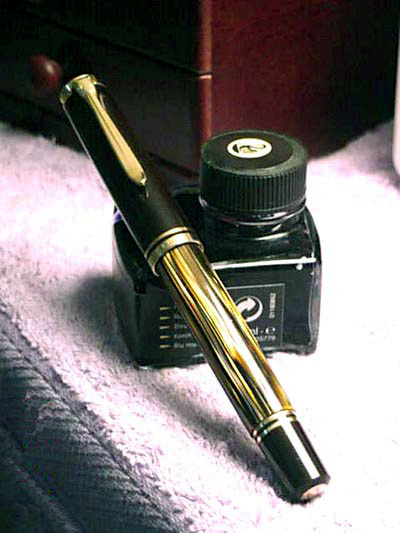
Above and below: From the collection
of Henry C. Przygoda/photography by Henry C. Przygoda. Uncommon Pelikan M800s
in tortoise, circa 1987.
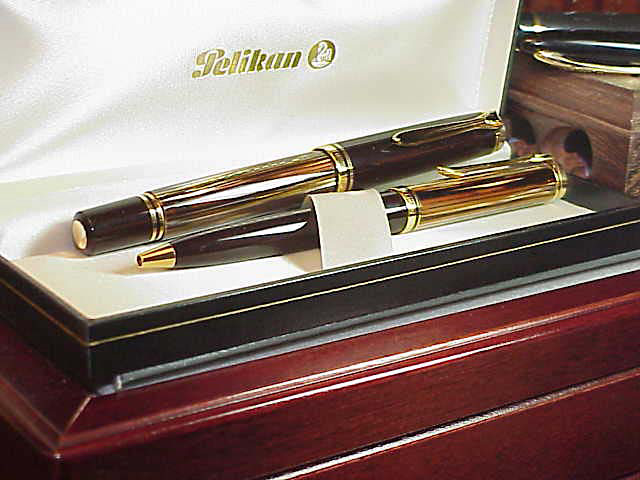
To then, the history of Pelikan had been a history of small, light pens. Even
as the company’s rivals, most notably Montblanc and Osmia, moved toward
larger pens as early as the 1930s, Pelikan remained with its core size, ranging
from the diminutive 4 3/4 inches of the 100 to a maximum of 5 1/4 inches for the
slender 400NN. The 800, with a smooth brass filling mechanism was neither small
nor light and was, presumably, meant to go up against the larger contemporary
Montblanc149. The 800, first in traditional black and green and all black, and
then followed by an extremely small run of tortoise models, and later blue and
in red, aimed at the emerging prestige pen market so dominated by the pens with
the white star. Pelikan also used the 800 as a platform for a whole raft of Limited
and Special Editions, beginning with the M900 and 910 Toledos and the green transparents
of the early 1990s and continuing to this day. The 800 also inspired a number
of custom penmakers who used the now famed 800 as a platform for authorised and
unauthorised custom versions of the pen. A decade later Pelikan again took on
the legendary Montblanc 149 with an even larger pen the M1000.
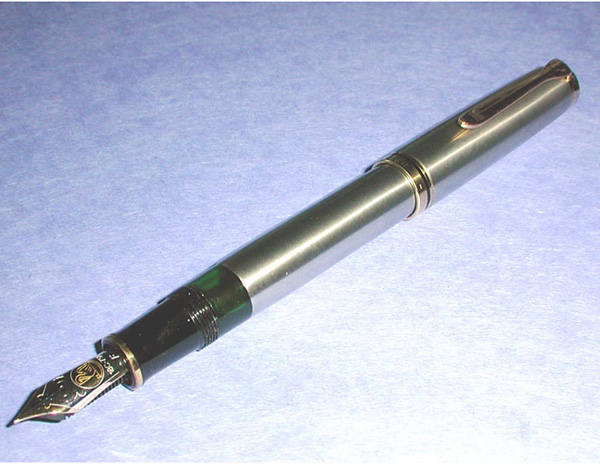
From the collection of Rick Propas/photography
by Rick Propas. Pen made of Pelikan M800 components sheathed in Titanium by Grayson
Tighe, 2001.
Finally, in 1997, the firm launched the “Originals of Their Time”
series. Beginning with an evocation of the 1931 111 gold banded model, over the
next six years the company released five pens in this series, three in precious
metals and two in celluloid, the green and blue 1935s. In 2003, the series was
concluded with its crown jewel, a Toledo that very closely followed the 111T of
the 1930s. As I have written elsewhere, the series was bold and courageous, faithfully
evoking the firm’s roots, that diminuitive first pen. At a time when luxury
pens screamed, “look at me, my owner is wealthy,” the Originals sat
demurely in desk or pocket reminding the user that this was a firm which, through
the twists and turns, the horror and change of the twentieth century, survived
by, for the most part, staying true to itself.
Note: Any history of Pelikan must rely on
two basic accounts, those of Jürgen Dittmer and Martin Lehmann in Pelikan
Schreibgeräte, and Andreas Lambrou, most completely in Fountain Pens of the
World. In addition, I have used Pelikan’s own company history, available
at ChartPak. I also
found helpful material in The PENnant (vol.XV, no.2, Summer 2001) which was devoted
to Pelikan and which I edited. Other material on pen history in general came from
Bowen and Lambrou. There is a small amount of useful Pelikan material in Miroslav
Tischler’s Penkala Writing Instruments. Regina Martini’s Pens &
Pencils, is a good source for identifying models and for background.
I am indebted to Gerhard Brandl, Jurgen Dittmer, Martin Lehmann,
Sharon Propas and Len Provisor who read, commented and fact-checked this history.
I, and not they, however, am responsible for all errors, omissions and bad commas.
Text © 2003 Rick Propas. Photos © 2003 as indicated in
captions.
|